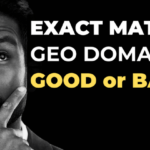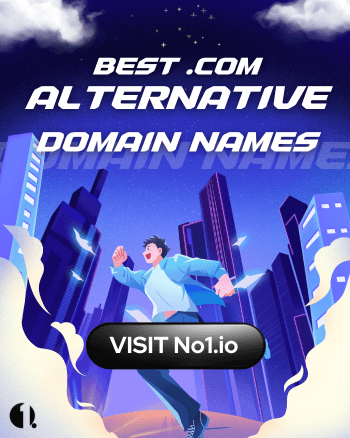When a Domain Name Starts to Work Against You
When you first launched your business, you needed a domain—fast. The ideal .com was taken or too expensive, so you got creative.
Maybe you added “hq,” “solutions,” or “get” in front. Maybe you went with a .net or .co because it was available and affordable.
At the time, it felt like a minor compromise.
But now you’re growing. You’re investing in marketing, building partnerships, getting PR—and suddenly, the domain that once “just worked” is showing cracks and you realized your domain name too long that causes:
- Customers can’t remember the exact address.
- Emails get bounced because someone typed in the wrong extension.
- People hear your brand and instinctively visit the .com—which someone else owns.
- You lose referral traffic because the domain is too long to say out loud or easy to misspell.
It’s frustrating because it’s invisible in your metrics.
You might not see a red flag in Google Analytics—but you feel its:
Missed opportunities.
Lower conversion rates.
A brand that isn’t quite as memorable or trustworthy as it could be.
Your domain name should be working for you—building trust, reinforcing your brand, and making it easier for customers to say, share, and remember your business.
But if your domain is awkward, overly long, or not aligned with your brand anymore… it’s not just a technical issue.
It’s a branding liability.
Why Long or Confusing Domain Names Are a Problem
At first glance, a long or “good enough” domain might not seem like a big deal. After all, it technically works, your website loads, and you’ve managed to build a business around it.
But here’s the quiet reality many business owners discover too late:
If your domain is hard to say, spell, or remember… it’s already costing you.
Not in a dramatic way—like your site crashing or emails failing—but in subtle, compounding losses that add up over time:
1. They’re Hard to Remember
In a world of instant decisions and short attention spans, a long or awkward domain is easy to forget. When customers can’t recall your name—or misspell it when trying to return—they’re gone.
“Wait, was it GreenLeafSolutionsOnline.com or GreenLeaf.com?” That hesitation = lost traffic.
People forget it after hearing it once.
Whether it’s on a podcast, pitch deck, or referral from a client, if your domain is too long or awkward, you’ll constantly repeat it—or worse, lose attention altogether.
2. They Hurt Word-of-Mouth Marketing
Great domains are shareable. They sound good when spoken. But if yours is hard to pronounce, filled with hyphens or weird abbreviations, people avoid saying it out loud—and that limits your growth.
A clean domain like Beacon.com practically shares itself.
A clunky one like BeaconBusinessSolutionsOnline.net?
People hesitate to say it aloud, and that hesitation kills momentum.
3. They Can Undermine Brand Trust
Customers judge businesses fast—especially online. A long, clunky, or off-brand domain can come off as unprofessional or even spammy.
When someone visits your site for the first time and sees a URL that looks overly complicated, they pause.
“Is this a real company? Is it legit? Why couldn’t they get a better domain?”
That hesitation—even if just for a second—can derail trust and conversions.
4. They Create SEO and Usability Friction
While domain length itself isn’t a direct SEO ranking factor, it impacts:
- User experience (confusion = higher bounce rates)
- Click-through rates (longer URLs are less appealing in search results)
- Linkability (people hesitate to share or link to awkward domains)
In other words, if your domain confuses users, it will affect how you show up in search engines—even if you’ve nailed your content strategy.
5. It Undercuts Your Branding
You’ve invested in a sleek logo, professional website, brand messaging—but your domain doesn’t reflect that polish. A mismatched domain feels like showing up to a boardroom in sweatpants.
The truth is, long or confusing domain names don’t just affect how people type your address. They affect how people feel about your brand. And in today’s crowded, digital-first market—first impressions are everything.
The strongest brands aren’t just remembered—they’re repeatable.
Real-World Examples of Smarter Domain Choices
Let’s face it—most of us don’t land the perfect domain on day one. We compromise. We add extra words. We settle for what’s available. But over time, the best brands don’t just build strong products—they build around strong domain names, too.
Whether it’s clarity, memorability, or pure brand value, great domains do one thing really well:
They make your business easier to find, share, and trust.
Below are real companies—big and small—that invested in short, simple, and powerful domain names to elevate their branding, reduce confusion, and scale with confidence.
These aren’t hypotheticals or “someday” ideas. These are live, functioning, real-world examples of how smart domain decisions lead to better brand outcomes.
Let’s take a look.
Dropbox.com
Simple, two syllables, easy to say and spell.
The domain reinforces what the product does—”drop your files in a box.”
Canva.com
Short, catchy, globally recognized.
A perfect example of a brandable name that didn’t rely on keywords, just clarity and usability.
Slack.com
One-word, punchy, and clean.
The name doesn’t describe the product directly—but it’s memorable and scalable across markets.
Loom.com
Another one-word .com.
Easy to remember and ideal for word-of-mouth, Loom turned a real English word into a modern SaaS brand.
Stripe.com
Financial and sleek.
Stripe is a great example of a domain that matches its B2B fintech audience—one-word, brandable, and strong.
Monday.com
Smart use of a common word + .com.
It’s memorable, brand-neutral (can expand into multiple services), and speaks to routine/work instantly.
Figma.com
Unique, short, and scalable.
Even as a made-up name, Figma is easy to remember and spell—a key win in domain strategy.
Trello.com
Made-up but flows well.
Easy to speak, type, and share—perfect for a collaboration tool.
Notion.so
While not a .com, it’s so clean and brandable that the .so works.
Their brand is strong enough that people associate “Notion” with their product immediately.
Ask Yourself: Does My Domain Name Pass the “Say-It-Once” Test?
Here’s a simple but powerful truth:
If someone has to ask you to repeat your domain name… you’ve already lost a little trust.
Think about how often your domain shows up in real-world conversations—a podcast interview, a client pitch, a networking event, or even casual word-of-mouth.
You mention your business, and someone asks:
“Nice—what’s your website?”
If you can say your domain once, and they remember it, spell it right, and actually visit it later—that’s a great domain.
But if your name has hyphens, numbers, unusual extensions, or too many words jammed together, things fall apart fast:
- “Wait, was that .com or .net?”
- “Do I need to include ‘online’ in the name?”
- “Is that all one word?”
That hesitation? That confusion? That’s friction. And in a crowded digital world, friction kills momentum.
The Say-It-Once Rule:
A great domain name should be:
- Easy to say
- Easy to spell
- Easy to remember
- Easy to type later—without needing to write it down
Because your domain name isn’t just what people see on your website.
It’s what they repeat when they share your brand.
If your domain fails the Say-It-Once test, it’s not just a technical issue—it’s a branding issue. One worth fixing sooner than later.
This is just one of many domain mistakes businesses make.
Explore the full list of Top 10 Domain Mistakes That Could Cost Your Business More Than You Think to see how your domain measures up.
Watch: How to Choose a Domain Name That Sets You Up for Success

In this quick video, we break down the mindset and tactics behind choosing a domain that supports your brand growth—from naming clarity to extension trust.
But What If I Already Launched With a Long Domain?
You’re not alone. Thousands of startups and small businesses begin with the only domain they could afford or find.
The good news?
You can fix it—without losing your SEO or traffic.
How to Fix a Long or Hard-to-Remember Domain (Without Breaking SEO)
Step 1: Find a Simpler Domain Variant
Search for: a shorter version of your name, a relevant brand keyword, a brandable alternative (think Chatly.com instead of ChatPlatformSolutions.com)
You can check domain marketplaces like DotWorldBrands.com, GoDaddy, or Sedo for premium and brandable options.
Step 2: Set Up a 301 Redirect
Once you acquire a better domain, redirect all traffic from the old one to the new one using 301 redirects.
This tells search engines to pass SEO value and ensures users end up in the right place.
Step 3: Update Your Branding
Refresh your website copy, email footers, business cards, and social profiles. Make the change clear and position it as a brand upgrade, and inform your clients and customers about the changes.
“We’ve simplified our domain to make it easier to find us. Check out our new home at MyBrand.com!”
Step 4: Keep the Old Domain (At Least for a Year)
Continue renewing your old domain to protect your brand from confusion or cybersquatters, and keep redirects active.
The Right Domain Is a Business Asset—Not Just an Address
Your domain name is often your first impression, your referral engine, and your long-term brand equity.
If it’s too long, too awkward, or too forgettable—it’s not just inconvenient.
It’s costing you trust, traffic, and revenue.
The best time to fix your domain name was when you launched.
The second-best time is now.
Need Help Finding a Better Domain?
At NamesDigest, we help founders, brand managers, and marketers:
- Identify brandable, SEO-friendly domain alternatives
- Secure premium .coms and strategic extensions
- Switch domains without sacrificing search performance
Contact us today about upgrading your domain
Struggling with your domain? You’re not alone.
Our guide on the Top 10 Domain Mistakes breaks down the most common—and costly—errors brand owners make, and how to avoid them.













